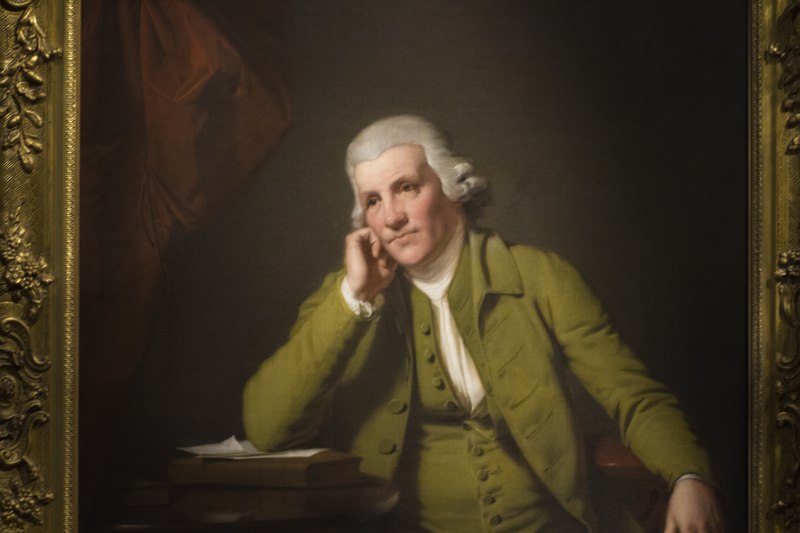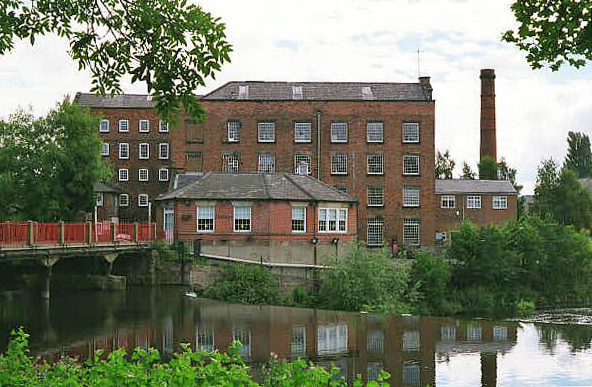By Lauren Gilbert
Elizabeth Evans was the daughter of a wealthy, self-made businessman. She married a man who was the son of a businessman, who was successful himself in his family's business, and, after his death, married his half-brother. During her second marriage, as a partner in the bank and businesses, Elizabeth utilized talents to make her mark as a businesswoman and as a philanthropist. During the Georgian era, women were theoretically subsumed into their husbands. However, there were some women who managed to make their marks in the business world. Elizabeth Evans was one of them.
Elizabeth Strutt was born sometime around 1755-1758 at Darley, Derbyshire, England. She was the second child and first daughter born to Jedediah Strutt and his wife Elizabeth Woollatt. Jedediah was born to a farming family on July 25, 1726 in South Normanton, Derbyshire, England. He became a cotton spinner and invented the Derby Rib Machine for making stockings, and was in partnership with Richard Awkright in cotton manufacturing. In partnership with his wife’s brother, Richard Awkright and others, Jedediah built mills, becoming a wealthy and influential man. He died May 6, 1797 in Derbyshire and was buried in the Unitarian chapel in Field Row, Belper. Elizabeth’s mother Elizabeth Woollatt was born in 1729 in Belper, Derbyshire, England. She married Jedediah on September 24, 1755 in Blackwell by Ale, Derbyshire, England, and died in May 1774 in London.
 |
| Photo of porttrait of Jedediah Strutt by Joseph Wright of Derby taken by Nero Reising-Wikimedia Commons-Creative Commons license |
Jedediah became a member of the Unitarian Dissenters, and had a strong belief in philanthropy. His church founded schools and churches, and supported reform. Among other things, Jedediah built housing for workers. He built and educated his family on the Unitarian principles.
Elizabeth had three brothers and one sister: William Strutt (born July 20, 1756, died December 9, 1830), Martha Strutt (born 1760, died 1793), George Benson Strutt (born 1761, died in September, 1841) and Joseph Strutt (born 1765, died Jan 13, 1844). After their mother’s death, her father did not return to his young family for nine months, leaving Elizabeth (in her mid-teens) responsible for her brothers and sister as well as the family home, farm and dairy.
Jedediah Strutt believed in education. Elizabeth’s father may have provided her with a governess or sent her to school. He provided her with books, which he expected her study, and she also had French lessons. She also encouraged her younger brothers William and Joseph in their studies.
Jedediah Strutt subsequently married Anne Cantrell in 1781; she died in 1802 (they had no children).
Elizabeth married William Evans on October 30, 1785 at St Peter’s Church, Derby, Derbyshire England. William was born about 1755, and was the elder son of Thomas Evans who had founded a bank in 1771, owned paper mills at Darley and other ventures. William and his half- brother Walter were partners in the bank with their father by 1780. The family built the Boars Head Cotton Mill, which was fully operational in 1782-1783 at Darley Abbey, where they had other business interests.
Elizabeth had three brothers and one sister: William Strutt (born July 20, 1756, died December 9, 1830), Martha Strutt (born 1760, died 1793), George Benson Strutt (born 1761, died in September, 1841) and Joseph Strutt (born 1765, died Jan 13, 1844). After their mother’s death, her father did not return to his young family for nine months, leaving Elizabeth (in her mid-teens) responsible for her brothers and sister as well as the family home, farm and dairy.
Jedediah Strutt believed in education. Elizabeth’s father may have provided her with a governess or sent her to school. He provided her with books, which he expected her study, and she also had French lessons. She also encouraged her younger brothers William and Joseph in their studies.
Jedediah Strutt subsequently married Anne Cantrell in 1781; she died in 1802 (they had no children).
 |
| William Strutt, oldest son of Jedediah Strutt, by Ramsay Richard Reinagle, Wikimedia Commons-Public Domain |
 |
| Darley Abbey-Boars Head Mills taken by Dave Bevis August 21, 2015- Wikimedia Commons-Creative Commons license |
Thomas Evans and his children first lived at Darley Fields
(later renamed Darley House), construction of which had begun in 1791. William
and Elizabeth took up residence at some point. The Strutts and the Evans families were known
to one another. They were involved in
various improvements in the community of Derby, such as streets, lighting
bridges, etc. and did business together. (William and Walter’s sister Barbara married Elizabeth’s brother William,
so there were other family as well as business ties.)
William and Elizabeth had six children: Elizabeth (Bessie), born in 1786; William, born in 1788; Frances, born in 1790; George, born in 1789, died in 1804 (he drowned at the age of fifteen); Ellen, born in 1795 and Thomas, born in 1796, died April 4, 1797. Upon her marriage, Elizabeth also took on Samuel Evans, her husband’s illegitimate infant son born in 1785. Samuel was raised by Elizabeth, but not as the eldest son and heir.
According to the DERBY MERCURY of Thursday, March 24, 1796, William died the previous Friday (March 18, 1796). Upon William’s death, Elizabeth was appointed a partner in the bank. Their infant son Thomas died not long after William. Their combined deaths were devastating to Elizabeth.
There was a connection at that time to Samuel Taylor Coleridge through their Unitarian faith and ideals. He became acquainted with the Strutt family in 1796. Elizabeth wanted to engage him as tutor to her children, and he intended to accept, but both families objected (possibly because of Coleridge’s political ties, possibly because of a concern that Elizabeth might be too fond of him), so the plan was abandoned.
Subsequently, Elizabeth married her late husband’s half-brother Walter two years later in 1798. They had one child, Arthur, born in 1800. Available data indicates Elizabeth began to become active in the bank with Walter at this time. Massive expansion of the mills occurred between 1818-1821. She also had partnership in other Evans businesses. Her brother William continued the cotton factory and paper mills at Darley. She and Walter and their family lived at Darley House.
Elizabeth continued in the Unitarian faith, and both she and Walter were deeply involved in philanthropy. Elizabeth was also interested in political reform (her correspondence indicates Elizabeth had abolitionist sympathies). The Evans family also built workers’ homes, with homes at Darley Abbey as early as 1795 and possibly earlier. School rooms were also built between 1797-1800. Walter also oversaw the building of a church.
In her mature years, Elizabeth continued in the bank partnership until she retired from that in 1808. She retired from her other business activities gradually, and was completely retired by 1810. Her father-in-law Thomas Evans died March 1, 1814 in Derby. Elizabeth died in early 1836 at approximately age 78, and was buried March 24, 1836 at Darley Abbey. According to the DERBYSHIRE COURIER of September 14, 1839, Walter died the previous Monday, (September 9, 1839) at Darley. He was buried at Darley Abbey on September 14, 1839.
Her stepson Samuel was an active partner in the bank. Her son William took less interest in the bank and other family businesses. He was knighted, served as a Member of Parliament, and settled into life as a politician and country landowner at Allestree Hall.
SOURCES INCLUDE:
Dawes, Margaret and Selwyn, Nesta. Women who made money WOMEN PARTNERS IN BRITISH PRIVATE BANKS 1752-1906. 2010: Trafford Publishing, Bloomington, IN.
Belpernorthmill.org.uk Derwent Valley Visitor Centre. “Jedediah Strutt” (pamphlet-pdf). HERE
Belperunitarians.org “Belper Unitarian Chapel” (pamphlet-pdf). No author or date of publication shown. HERE
Countryimagesmagazine.co.uk “Darley House” by Steve Orme, posted February 27, 2017. HERE
DerbyshireAS.org. DERBYSHIRE MISCELLANY. Vol. 8 Autumn 1979, Part 6. “The Borough of Derby between 1780 and 1810” by John E. Heath. PP. 181-197. HERE
Books.google.com Burke, Sir Bernard. A GENEALOGICAL AND HERALDIC HISTORY OF THE LANDED GENTRY OF GREAT BRITAIN AND IRELAND, Volume 1. 1882: London: Harrison, Pall Mall. HERE ; Lee, Sidney (ed.). DICTIONARY OF NATIONAL BIOGRAPHY, Volume 19. “Strutt, Jedediah (1726-1797). Pp. 64-67. 1909: London, Smith, Elder and Co. HERE
Friendsofcoleridge.com THE COLERIDGE BULLETIN The Journal of the Friends of Coleridge, NS 28 Winter 2006. “Coleridge and the Unitarian Ladies” by Felicity James. HERE
Historyofparliamentonline.org “Evans, William (1788-1856), of Allestree, Derbys. by Simon Harratt. HERE
RBS.com “W & W Evans & Co.” (no author or post date shown). HERE
~~~~~~~~~~~~
An avid reader, Lauren Gilbert was introduced to English authors early in life. Lauren has a Bachelor of Arts degree in liberal arts English with a minor in Art History. A long time member of JASNA, she has presented a number of programs. She lives in Florida with her husband. Her first book, HEYERWOOD A Novel, is available. A RATIONAL ATTACHMENT is her newest release. Both can by found at Amazon and other booksellers. A long-time contributor to the English Historical Fiction Authors blog, her work is included in both volumes of CASTLES, CUSTOMS AND KINGS: True Tales by English Historical Fiction Authors. She is also working on a nonfiction book about powerful women in Regency era Europe. For more information, visit her website HERE.
An avid reader, Lauren Gilbert was introduced to English authors early in life. Lauren has a Bachelor of Arts degree in liberal arts English with a minor in Art History. A long time member of JASNA, she has presented a number of programs. She lives in Florida with her husband. Her first book, HEYERWOOD A Novel, is available. A RATIONAL ATTACHMENT is her newest release. Both can by found at Amazon and other booksellers. A long-time contributor to the English Historical Fiction Authors blog, her work is included in both volumes of CASTLES, CUSTOMS AND KINGS: True Tales by English Historical Fiction Authors. She is also working on a nonfiction book about powerful women in Regency era Europe. For more information, visit her website HERE.


always interesting to read about people I've never heard of. I hated this period when I was at school because the teacher was so _boring_ - the only thing I can remember is the spinning jenny, and that's purely because on first hearing about it, in my mind I pictured a female donkey whizzing round in circles (I've still no idea of what an actual spinning jenny did! LOL)
ReplyDelete